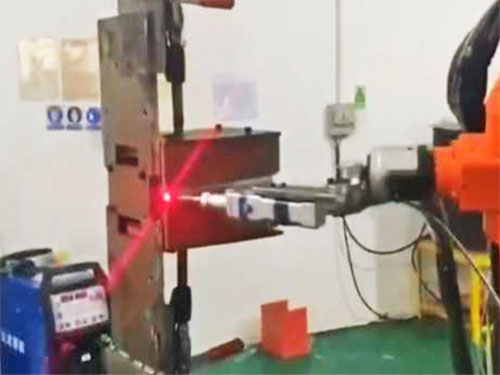I. Basic Structure and working principle of Four-axis palletizing robot
The four-axis palletizing robot is mainly composed of mechanical arm, workbench, control system, camera and other components. Its working principle is based on the advanced computer control system, which realizes the grasping, handling and palletizing of materials by precisely controlling the movement of the robot arm. This robot has four degrees of freedom and can move flexibly in three-dimensional space to complete complex palletizing tasks.
Two, the core role of the four-axis palletizing robot
Improve production efficiency: The four-axis palletizing robot can continuously and stably carry out palletizing operations, greatly reducing the waiting time and rest time of manual operation. At the same time, due to its high speed and high repeatability, the robot can complete the palletizing of a large number of materials in a short time, significantly improving production efficiency.
Reduce labor intensity: Traditional palletizing operations require workers to carry out a lot of repetitive labor, not only labor intensity, but also easy to cause industrial accidents. The application of four-axis palletizing robot enables workers to be liberated from heavy physical labor, reduces labor intensity, and protects the health of workers.
Improve the quality of palletizing: The four-axis palletizing robot uses an advanced control system and accurate sensors to achieve accurate identification and positioning of the material position. This enables the robot to accurately place the material in the specified position during the palletizing process, avoiding the error and instability that may occur in manual palletizing, and improving the palletizing quality.
Strong adaptability: The four-axis palletizing robot can be flexibly adjusted according to different material types, sizes and weights to adapt to different palletizing needs. At the same time, the robot can also automatically switch and combine palletizing according to preset procedures to meet the needs of personalized and customized production.
Realize intelligent management: The four-axis palletizing robot can be seamlessly connected with the warehouse management system to achieve real-time data transmission and sharing. This allows enterprises to monitor material inventory, production progress and other information in real time, providing strong support for decision-making. At the same time, the robot can also optimize palletizing strategies through data analysis to further improve production efficiency and quality.
Application of four-axis palletizing robot in different fields
In the field of logistics and warehousing: four-axis palletizing robots can replace manual palletizing operations of goods, improve the utilization rate of storage space and operation efficiency. Robots can stack goods in a certain way according to preset rules and procedures, saving space and reducing human errors. In addition, robots can also enable smarter warehouse management and automated transportation through network connectivity and data interaction.
Manufacturing: Four-axis palletizing robots can be used to stack and package finished products, improving the automation of the manufacturing process. The robot can stack and pack the product in a prescribed way according to a preset procedure, ensuring product quality and consistency. At the same time, the robot can also realize the flexible switching and combination of a variety of products to meet the needs of personalized and customized production.
Advantages and Challenges of Four-axis palletizing robots
Advantages: The four-axis palletizing robot has the advantages of high precision, high efficiency, versatility and flexibility. It can accurately place materials, improve the quality of palletizing; At the same time, its high speed and high repeatability can significantly improve production efficiency. In addition, robots can also adapt to different production needs and work scenarios, providing more flexible solutions.
Challenges: Despite the many advantages of four-axis palletizing robots, their application also faces some challenges. First, the initial investment cost of robots is high, which may be unbearable for some small businesses. Secondly, the maintenance and maintenance of the robot requires a certain amount of technology and experience, and requires a dedicated team to manage and maintain. In addition, with the continuous development of technology, robots need to be constantly updated and upgraded to adapt to new production needs and technological changes.
Five, the future development of four-axis palletizing robot
With the continuous development of artificial intelligence, machine vision and other technologies, four-axis palletizing robots will achieve more intelligent and autonomous operation. Robots of the future will be able to identify materials more accurately, adjust palletizing strategies more quickly, and collaborate seamlessly with other smart devices to build efficient, intelligent production lines. At the same time, with the continuous popularization of robotics and the continuous reduction of costs, four-axis palletizing robots will be applied in more fields, providing strong support for the production and development of enterprises.
Summary: Four-axis palletizing robot plays an important role in improving production efficiency, reducing labor intensity and improving palletizing quality. With the continuous progress of technology and the continuous expansion of application fields, robots will play a more important role in the future and make greater contributions to the sustainable development of enterprises. However, the application of robots also needs to fully consider its investment costs, maintenance and technical updates and other issues to ensure that robots can bring long-term benefits and value to enterprises.




 WeChat QR code
WeChat QR code